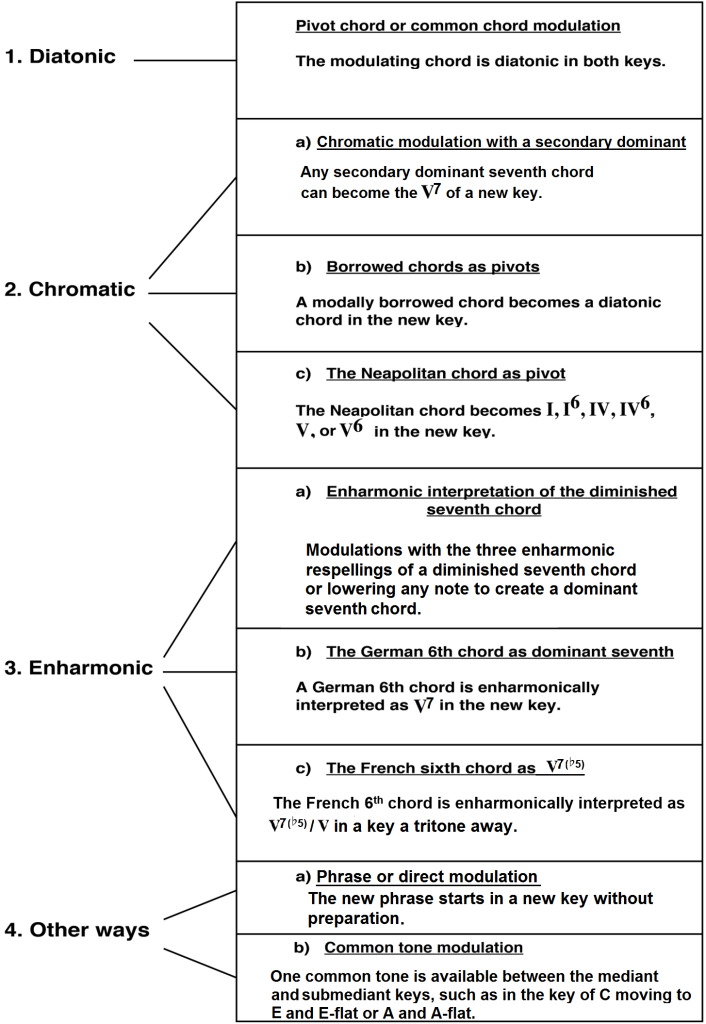29 Enharmonic Modulation and Other Types of Modulation
Enharmonic modulation
The most frequently used enharmonic devices:
A. Enharmonic reinterpretation of a diminished seventh chord.
B. Lowering one note of a diminished seventh chord by a half step to create a dominant seventh chord.
C. Enharmonic reinterpretation of a Ger6 chord as a dominant seventh chord.
D. Enharmonic reinterpretation of a Fr6 chord into a root position French chord in a major/minor key a tritone away.
A. Enharmonic reinterpretation of a diminished seventh chord
The diminished seventh chord equally subdivides the octave, with every interval in the chord being a minor third. Because of this equal subdivision of the octave, any diminished seventh chord can be enharmonically spelled four different ways.

Depending on the enharmonic spelling, a diminished seventh chord thus can resolve to three other pairs of parallel major or minor keys. A single diminished seventh chord can thus resolve to the tonic in eight different keys:
In the example below, the Bo7/F chord in C major is reinterpreted as Bo7/D in E![]() major.
major.
Practice
Create your own modulations using a reinterpreted diminished seventh chord.
B. Changing a diminished seventh chord into a dominant seventh chord
The diminished seventh chord is closely related to the dominant seventh chord. Any one of the four notes of a viio7 chord can be lowered by a half step to create a V7 or V7 inversion. In reverse, raise the root of any V7 or secondary dominant V7 by a half step to create a viio7 chord.
The example below shows a reinterpreted secondary diminished seventh chord altered into a dominant seventh chord of the new key.
*C![]() o7 = Eo7/D
o7 = Eo7/D![]() and then changed into E
and then changed into E![]() 7/D
7/D![]()
In the example below, the Bo7/A![]() chord in C minor is considered to be E
chord in C minor is considered to be E![]() o7/G
o7/G![]() , which is the leading tone seventh chord of F
, which is the leading tone seventh chord of F![]() major. The chord is then altered into a dominant seventh chord inversion in the new key.
major. The chord is then altered into a dominant seventh chord inversion in the new key.
Practice
Create your own modulations using a reinterpreted secondary diminished seventh chord altered into a dominant seventh chord.
C. Enharmonic interpretation of a German sixth chord
as dominant seventh chord
A German sixth chord becomes a dominant seventh chord by the enharmonic respelling of the A6 as a m7. In the reverse, a dominant or secondary dominant can assume the role of a German sixth chord by respelling the m7 as an A6. This device allows for modulations to distant keys.
In the example below, the V7 chord in C minor becomes the Ger6 chord in B minor.
Practice
Create your own modulations using the German sixth chord as dominant seventh chord. Also do the reverse.
D. Enharmonic reinterpretation of a Fr6 chord
into a root position french chord
in a major/minor key a tritone away
A less common modulatory device is to consider a root position French chord in the home key as enharmonically equivalent to a French sixth chord in a key a tritone away or vice versa. For example, C to F![]() and f
and f![]() :
:
In the example below, the Fr7 chord in C major becomes the Fr6 chord in F![]() minor.
minor.
Practice
Create your own modulations using the French sixth chord.
Other Types of Modulation
A. Phrase Modulation
In a phrase modulation the composer ends a phrase in one key and then abruptly starts the next phrase in a new key.
B. Common-tone Modulation
In a common-tone modulation the composer uses a single note, often the ending melody note, as a pickup note to move from one key to another. The most typical common-tone modulation is to use the root of the tonic chord (for example, G in G major) as the 3rd of a chord in the new key, or vice versa. This approach allows for a modulation to keys a M3 or m3 either up or down: III, ![]() III, VI, or
III, VI, or ![]() VI.
VI.
Practice
Create your own phrase and common-tone modulations.
Summary of Modulations
